|
 Clavulina samuelsii Clavulina samuelsii
BiostatusPresent in region - Indigenous. Endemic
Images (click to enlarge)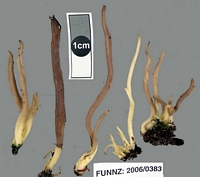
Caption: Col. DA0455, FUNNZ: 2006/0383, See public note for more information
Owner: FUNNZ | 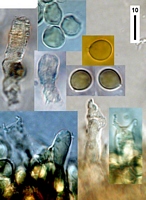
Caption: Col. DA0455, FUNNZ: 2006/0383, See public note for more information
Owner: FUNNZ | 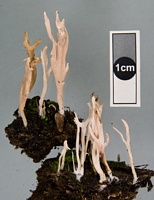
Owner: J.A. Cooper | 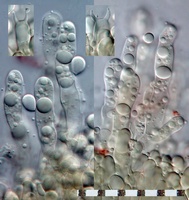
Caption: septate emergent cystidia and basidia.
Owner: J.A. Cooper | 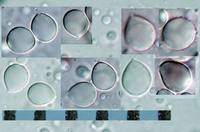
Caption: spores
Owner: J.A. Cooper | 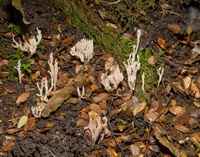
Owner: J.A. Cooper |
Article: Petersen, R.H. (1988). The clavarioid fungi of New Zealand. New Zealand Department of Scientific and Industrial Research, Bulletin 236: 170 pp. Wellington:.
Description: Fruit bodies up to 35 x 4 mm, usually simple and then narrowly fusiform to subcylindrical with club and stipe flattened somewhat, to occasionally branched, and then branches few, often appearing adventitious, with acute axils and lobed apices, arising from significant white mycelial mat, often connate into groups of 2-4; colour violaceous ivory-colour ("tilleul-buff") all over when young, slowly becoming tan to orange-ochre in the stipe; flesh white; hymenium amphigenous, pruinose under x100, especially on lower club; distinction between stipe and hymenium well marked, especially when dry.
Hyphae of club trama 2.5-6 gm diam., thin-walled, hyaline, clamped, long-celled, generally parallel. Subhymenial hyphae similar to those of the trama, short-celled, hardly inflated. Hymenium thickening significantly; basidia 60-70 x 7.5-9.5 gm, subcylindrical to narrowly clavate, more or less refringent when 'mature but without discrete guttules, clamped; sterigmata (1)-2-(3), stout, divergent, curved; post¬partal septation not observed; cystidia (Fig. 57) up to 150 gm long, cylindrical, arising in subhymenium, projecting from the hymenium up to 50 gm, 9-12 gm diam., septate 1-4 times, with clamps at all septa, golden-refringent apically.
Spores (Fig. 58) 7.2-9.4 x 6.1-7.6 gm (E =1.05-1.41; E'° =1.18; L'° = 8.35 gym), very broadly ellipsoid to broadly ellipsoid, thin-walled, opalescent (not discernibly uniguttulate) when mature; hilar appendix small, papillate.
Habitat: Under mixed forest, often with kauri.
Notes: All the collections cited were gathered under the name Clavulina tasmanica, at a time when I confused C. tasmanica and C. geoglossoides. Because the latter was so commonly collected, no fresh-colour notes were taken. On microscopic examination, however, cystidia are found consistently to be septate with clamps, to occur singly but abundantly, and spores are somewhat smaller and more ellipsoid than those of C. tasmanica. Moreover, dried specimens show tan to orange-ochre stipes (and overall colour when immature), not seen in dried material of C. tasmanica.
|